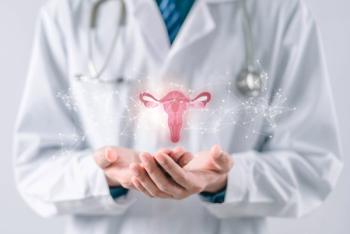
Acute on-set of Hematometra and Hematosalpinx in a non-communicating Rudimentary Horn
A case of unicornuate uterus with cavitary non-communicating rudimentary horn suddenly revealing with acute abdomen is presented. The patient was managed by laparoscopic miniaccess hemihysterectomy.
Reprinted with kind permission from
Introduction
A case of unicornuate uterus with cavitary non-communicating rudimentary horn suddenly revealing with acute abdomen is presented. The patient was managed by laparoscopic miniaccess hemihysterectomy.
Case Report
A 13-year-old girl with a history of primary amenorrhea presented with acute abdominal pain
Intervention
At laparoscopy, a massive hemoperitoneum was drained, resulting from a left hematosalpinx and hematometra originating from a left uterine rudimentary horn.
(Click images to enlarge)
The left hematometra was firstly drained and a salpingectomy was performed.
The hematometra was drained to allow complete visualization of the uterine cavity and his relationship with the right hemiuterus and vaginal canal.
Discussions
Non-communicating uterine horns are rare m?llerian abnormalities ( 39% of uterine anomalies), occasionally presenting with functional endometrial cavities. Surgical removal of the non-communicating horn is commonly performed if it is thought to contain functional endometrium, to prevent endometriosis and pregnancy complications, including miscarriage, ectopic pregnancy
Uterine anomalies are identified in 1 in 594 fertile women (0.17%) and in 1 in 29 infertile women (3.5%). This difference is statistically significant (chi 2 = 3,424, df = 1, P < .00001). The prevalence of uterine anomalies in the general population is 1 in 201 women (0.50%).
Literature data indicate the need to suspect a urinary tract anomaly, particularly of the kidney, in all women with a unicornuate uterus. Patients with uterine abnormalities have been reported to have urinary tract anomalies in about 40% of cases, including ectopic kidney, renal agenesis, double renal pelvis, horseshoe kidneys and unilateral medullary sponge kidney. No differences are observed in the frequency of urinary anomalies among the various subclasses of unicornuate uterus.
Conclusion
Congenital uterine malformations are more common than generally recognized. Knowledge concerning their prevalence and varieties is important in recognizing and managing the obstetric and gynecologic complications that may result. An unicornuate uterus with cavitary non-communicating rudimentary horn can cause hematometra and endometriosis leading to acute abdominal pain, infertility, rupture of pregnant rudimentary horn and obstetrical complications with pregnant semi-uterus. The rudimentary horn should be removed if detected.
References:
Related articles
Amara DP, Nezhat F, Giudice L, Nezhat C. Laparoscopic management of a noncommunicating uterine horn in a patient with an acute abdomen. Surg Laparosc Endosc 1997;7:56-59. (
Console D, Tamburrini S, Barresi D, et al. The value of the MR imaging in the evaluation of Mullerian duct anomalies. Radiol Med 2001; 102:226-232. (
Newsletter
Get the latest clinical updates, case studies, and expert commentary in obstetric and gynecologic care. Sign up now to stay informed.
















